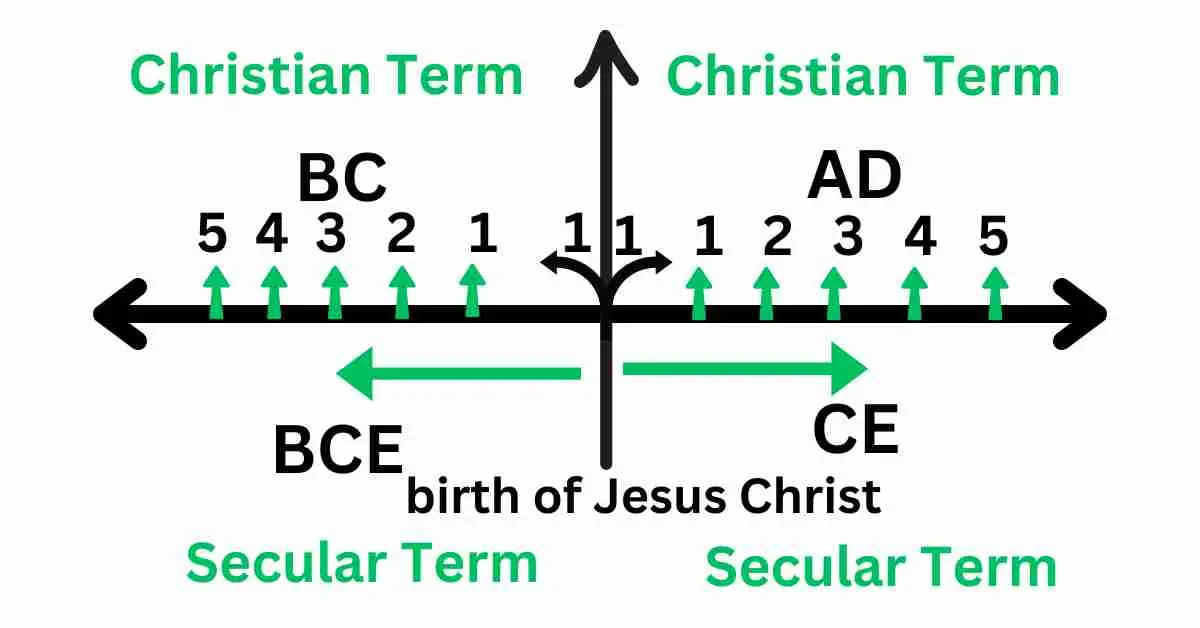You have to face AD, BC, BCE, CE whenever you read or watch historical content, whether it be in the form of a history book, novel, article, post, or historical videos, documentaries, movies, podcasts, or lectures in a classroom.
Let us examine AD BC BCE CE abbreviations thoroughly!
Introduction
The calendar system is necessary for understanding human history. It enables us to organize and understand time across centuries and millennia. It is rooted in astronomical observations and has evolved through cultural and scientific developments.
AD BC BCE CE are central to this system, providing a framework for dating historical events
What do AD and BC stands for?
BC (Before Christ)
BC stand for “Before Christ.” It is a term used to label or Count years before the estimated birth of Jesus Christ.
The designation of BC is used to denote years in the history and prehistory of the Earth and human civilization before the birth of Jesus.
BC starts with year 1 before the birth of Christ, which is the year before AD 1 and counts backward indefinitely.
Examples:
- Alexander the Great was born in 356 BC in Pella, Macedonia.
- The ancient Egyptians built the pyramids around 2500 BC.
- The Roman Republic was founded in 509 BC.
AD (Anno Domini)
AD stands for “Anno Domini,” a Latin phrase that translated to English as “In the Year of Our Lord,” label or count the years from the traditionally estimated birth of Jesus Christ.
AD starts with year 1, after the birth of Christ, and continues to the present day.
Examples:
- Prophet Muhammad was born in AD 570/71 in Makka.
- Christopher Columbus landed in America in AD 1492.
- The Treaty of Hudaibiya, was signed in Mecca in 628 CE.
No Year Zero:
The BC AD timeline has no year zero; the year following 1 BC is AD 1, with the birth of Jesus Christ as point zero on this dateline.
AD and BC are Abbreviations used to label or count years in the Gregorian Calendar, named after Pope Gregory XIII, who introduced it in 1582, and the Julian Calendar, proposed by Julius Caesar, a ruler of ancient Rome, which are the main calendars used in the world today. AD and BC are commonly used in academic writing, historical documents, and religious texts.

It is important to note that historical evidence suggests Jesus was actually born a few years earlier, around 4 BC, according to modern estimates.
There is a common misconception that AD stands for After Death (Means after the death of Jesus), which is incorrect.
Note: The abbreviation AD comes before the years, and the BE comes after the years. I.e., AD 1215, 556 BC. Here, English follows Latin usage by placing the “AD” before the year number, though it is also found after the year.
Historical Background
The AD (Anno Domini) and BC (Before Christ) systems we use today were not always the norms of the past world.
Before AD and BC, People used various methods to track time, often based on the rulers’ reigns or major events.
The background of AD (Anno Domini) and BC (Before Christ) dates back to the early medieval period. The AD system was devised in 525 by Dionysius Exiguus, a Scythian monk, to enumerate the years in his Easter table. His system replaced the Diocletian era, named after the Roman Emperor Diocletian, who persecuted Christians. Dionysius aimed to base his dating system on the incarnation of Jesus Christ, although the exact year of Christ’s birth was not accurately known. The term “Anno Domini” is Medieval Latin and translates as “in the year of the Lord,” referring to the era of Christ.
The transition to using AD and BC is essential because it provides a unified approach to marking historical time on a global scale.
Historical records and modern scholarship suggest Jesus was actually born around 4 BC, a few years earlier than AD 1.
What do BCE and CE stand for?
BCE (Before the Common Era)
BCE stand for “Before the Common Era,” used to label or count years before the birth of Jesus Christ.
The designation of BCE is used to denote years in the history and prehistory of the Earth and human civilization before the birth of Jesus.
BCE starts with year 1 before the birth of Christ, which is the year before 1 CE, and counts backward indefinitely.
Examples:
- Alexander the Great was born in 356 BCE in Pella, Macedonia.
- The ancient Egyptians built the pyramids around 2500 BCE.
- Siddhartha Gautama (The Buddha) was born in 623 BCE.
CE (Common Era)
CE stands for “Common Era” or “Christian era” and is used to label or count years after the birth of Jesus Christ.
CE starts with year 1, after the birth of Christ, and continues to the present day.
Examples:
- The Charter of Madina was written in 622 CE in Madina.
- Christopher Columbus landed in the Americas in
- 1492 CE. World War II ended in 1945 CE.
The BCE and CE timeline has no year zero; the year following 1 BCE is 1 CE, with the birth of Jesus Christ as point zero on this dateline.
Note that, unlike the BC and AD systems, the new system follows a format where both BCE and CE are written after the year.
BCE and CE are alternative notations for the traditional BC (Before Christ) and AD (Anno Domini) designations used in the Gregorian calendar, the most widely used calendar system.
CE (Common Era): Replaces AD and denotes the current era or the era after the birth of Christ.
BCE (Before the Common Era): Replaces BC and refers to years that came before the current era or before the birth of Christ.
Both CE and BCE use the same year numbering system as BC and AD. For instance, the year we are currently in is 2024 CE, or AD 2024.
Example:
- “2001 CE” is the same as “AD 2001.”
- “500 BCE” is the same as “500 BC.”
Historical Background
BCE and CE are relatively recent alternatives to the traditional BC (Before Christ) and AD (Anno Domini) symbols for years. While BC and AD refer to the birth of Jesus Christ, BCE and CE are entirely secular abbreviations.
The BCE and CE timeline has been employed in scholarly publications since the 17th century. It aims to be comprehensive by avoiding any claim to date the year of Christ’s birth, which remains unknown.
Their use became more widespread in the 20th century, particularly in academic circles, because they are more comprehensive of non-Christian cultures.
Why BCE and CE Are Used Today
The transition to Common Era (CE) and Before Common Era (BCE) was driven by the desire for a more comprehensive and secular approach to historical dating. Anno Domini (AD), which means “in the year of the Lord” in Latin, references Jesus Christ’s birth. BCE and CE are neutral terms that avoid religious references.
Here are some additional reasons for the shift:
- Avoidance of Christian centricity: The BCE and CE timeline is more inclusive of people who follow religions other than Christianity.
- Increased academic adoption: The BCE CE timeline has been more commonly used in academic circles since the late 20th century.
- Religious Neutrality: BCE and CE were introduced as neutral, inclusive Abbreviations to avoid the Christian-centric implications of BC (Before Christ) and AD (Anno Domini, “in the year of our Lord”).
- This change aimed to respect diverse cultures and religions that study and contribute to historical research.
- By using BCE and CE, historians avoid favouring one religious tradition over another, fostering a more balanced understanding of history.
Today, BCE and CE are recognized and employed globally in many academic, scientific, and historical contexts, offering a universal dating system not tied to religious connotations. BCE and CE timelines are generally preferred in scientific and academic writing.
Growing Preference in Academic and Scientific Contexts
BCE and CE find favour in scholarly circles. Academics, scientists, and historians increasingly adopt these designations due to their secular nature. By doing so, they avoid privileging any particular belief system.
Promoting Inclusivity and Neutrality
BCE/CE promotes inclusivity by accommodating diverse cultural and religious perspectives. They allow for a more respectful and unbiased representation of history. In international contexts, these terms foster understanding across borders.
The adoption of BCE and CE reflects a commitment to accuracy, all-embracing, and respect for diverse perspectives in historical chronology.
BCE and CE vs BC and AD
Similarities and Differences
Both AD BC and BCE CE systems share the same year count. The transition from 1 BC to AD 1 remains the same. However, BCE and CE prioritize a secular lens, while BC and AD carry religious undertones.
Counting Years
Regardless of the system, the counting of years remains unchanged. Whether we say 2024 CE or AD 2024, the passage of time remains constant.
Conclusion
The AD BC BCE CE dating systems provide a framework for understanding historical events and their chronological order. The adoption of the BCE CE timeline reflects a growing emphasis on cultural sensitivity and inclusivity in historical discourse.
BC and AD reference the birth of Jesus Christ, making it central to Christian traditions. BCE and CE avoid religious references, promoting inclusivity for non-Christians.
The use of BCE/CE has grown in academia since the late 20th century, reflecting a shift towards more neutral language in historical and academic discourse. However, BC/AD remains widely used.
Frequently Asked Questions
1. What does AD BC stand for?
BC stand for “Before Christ.” It is a term used to label or Count years before the estimated birth of Jesus Christ. It starts with year 1 before the birth of Christ and counts backwards indefinitely.
AD stands for “Anno Domini,” a Latin phrase that translated to English as “In the Year of Our Lord,” label or count the years from the traditionally estimated birth of Jesus Christ. It starts with year 1, after the birth of Christ, and continues to the present day.
2. What do BCE and CE stand for?
BCE stand for “Before the Common Era,” used to label or count years before the birth of Jesus Christ. It starts with year 1 before the birth of Christ and counts backwards indefinitely.
CE stands for “Common Era” and is used to label or count years after the birth of Jesus Christ.CE starts with year 1, after the birth of Christ, and continues to the present day.
3. What comes first, AD or BC?
BC comes before AD in chronological order. BC stands for years before the birth of Jesus Christ, while AD represents years after his birth.
4. Why were BCE and CE introduced?
The transition to CE and BCE was driven by the desire for a more comprehensive and secular approach to historical dating.
They promote inclusivity and neutrality in historical discourse and have gained increased adoption in academic and scientific contexts since the late 20th century.
5. Are there any differences in counting years between BCE and CE and BC and AD?
Both AD BC and BCE CE systems share the same year count. The transition from 1 BC to AD 1 remains the same. Regardless of the system, the counting of years remains the same. Whether we say 2024 CE or AD 2024, the passage of time remains constant.
6. Which calendar systems use AD, BC, BCE, and CE?
AD and BC are commonly used in the Gregorian and Julian calendars, while BCE and CE are alternative notations used in the Gregorian calendar.

Thank for sharing information
Thak for your encourage